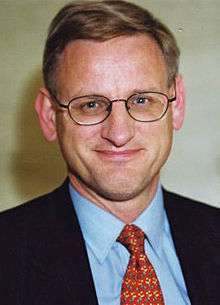Swedish general election, 1998
| |||||||||||||||||||||||||||||||||||||||||||||||||||||||||||||||||||||||||||||||||||||||||||||||||||||||||||||||||||||||
All 349 seats to the Riksdag 175 seats were needed for a majority | |||||||||||||||||||||||||||||||||||||||||||||||||||||||||||||||||||||||||||||||||||||||||||||||||||||||||||||||||||||||
| |||||||||||||||||||||||||||||||||||||||||||||||||||||||||||||||||||||||||||||||||||||||||||||||||||||||||||||||||||||||
| |||||||||||||||||||||||||||||||||||||||||||||||||||||||||||||||||||||||||||||||||||||||||||||||||||||||||||||||||||||||

Election results.
General elections were held in Sweden on 20 September 1998.[1] The Swedish Social Democratic Party remained the largest party in the Riksdag, winning 131 of the 349 seats.[2]
The incumbent Social Democratic minority government, led by Göran Persson, was returned to power despite losing seats and receiving fewer votes than in their 1991 defeat. They remained in power with support from the Left Party and the Green Party. While the three left-wing parties saw a net loss of 11 seats, the Left Party nearly doubled its representation in the Riksdag. This reflected how many Social Democratic voters were dissatisfied with the policies of the government, which had implemented austerity measures to reduce the budget deficit.
Results
| Party | Votes | % | Seats | +/– |
|---|---|---|---|---|
| Swedish Social Democratic Party | 1,914,426 | 36.4 | 131 | –30 |
| Moderate Party | 1,204,926 | 22.9 | 82 | +2 |
| Left Party | 631,011 | 12.0 | 43 | +21 |
| Christian Democrats | 619,046 | 11.8 | 42 | +27 |
| Centre Party | 269,762 | 5.1 | 18 | –9 |
| Liberal People's Party | 248,076 | 4.7 | 17 | –9 |
| Green Party | 236,699 | 4.5 | 16 | –2 |
| Swedish Senior Citizen Interest Party | 52,869 | 1.0 | 0 | 0 |
| The New Party | 25,276 | 0.5 | 0 | 0 |
| Sweden Democrats | 19,624 | 0.4 | 0 | 0 |
| New Future | 9,171 | 0.2 | 0 | 0 |
| New Democracy | 8,297 | 0.2 | 0 | 0 |
| Senior Citizen Party | 6,865 | 0.1 | 0 | 0 |
| Socialist Justice Party | 3,044 | 0.1 | 0 | 0 |
| Communist Party of Sweden | 1,868 | 0.0 | 0 | 0 |
| Enhet | 1,725 | 0.0 | 0 | 0 |
| Socialist Party | 1,466 | 0.0 | 0 | 0 |
| Other parties | 6,971 | 0.1 | 0 | 0 |
| Invalid/blank votes | 113,466 | – | – | – |
| Total | 5,374,588 | 100 | 349 | 0 |
| Registered voters/turnout | 6,603,129 | 81.4 | – | – |
| Source: Nohlen & Stöver | ||||
By municipality
 Votes by municipality. The municipalities are the color of the party that got the most votes within the coalition that won relative majority.
Votes by municipality. The municipalities are the color of the party that got the most votes within the coalition that won relative majority. Cartogram of the map to the left with each municipality rescaled to the number of valid votes cast.
Cartogram of the map to the left with each municipality rescaled to the number of valid votes cast. Map showing the voting shifts from the 1994 to the 1998 election. Darker blue indicates a municipality voted more towards the parties that formed the centre-right bloc. Darker red indicates a municipality voted more towards the parties that form the left-wing bloc.
Map showing the voting shifts from the 1994 to the 1998 election. Darker blue indicates a municipality voted more towards the parties that formed the centre-right bloc. Darker red indicates a municipality voted more towards the parties that form the left-wing bloc. Votes by municipality as a scale from red/Left-wing bloc to blue/Centre-right bloc.
Votes by municipality as a scale from red/Left-wing bloc to blue/Centre-right bloc. Cartogram of vote with each municipality rescaled in proportion to number of valid votes cast. Deeper blue represents a relative majority for the centre-right coalition, brighter red represents a relative majority for the left-wing coalition.
Cartogram of vote with each municipality rescaled in proportion to number of valid votes cast. Deeper blue represents a relative majority for the centre-right coalition, brighter red represents a relative majority for the left-wing coalition.
References
This article is issued from
Wikipedia.
The text is licensed under Creative Commons - Attribution - Sharealike.
Additional terms may apply for the media files.




